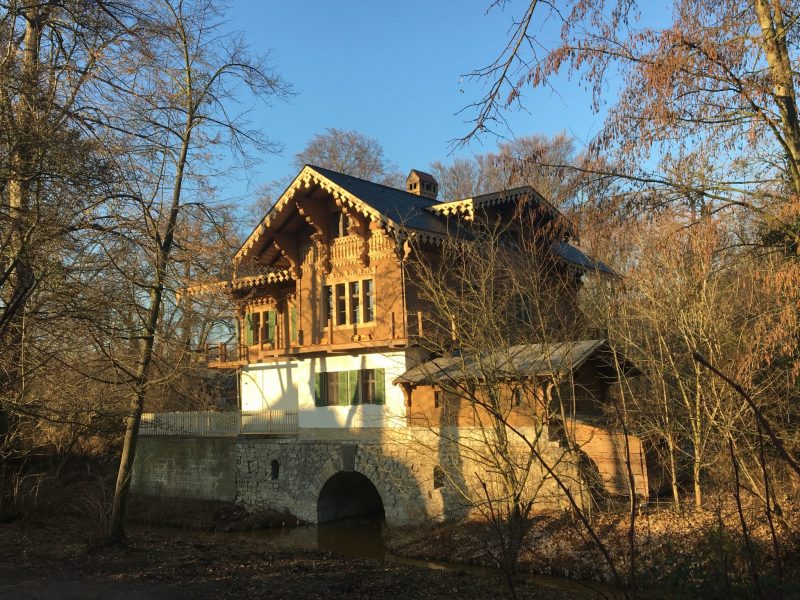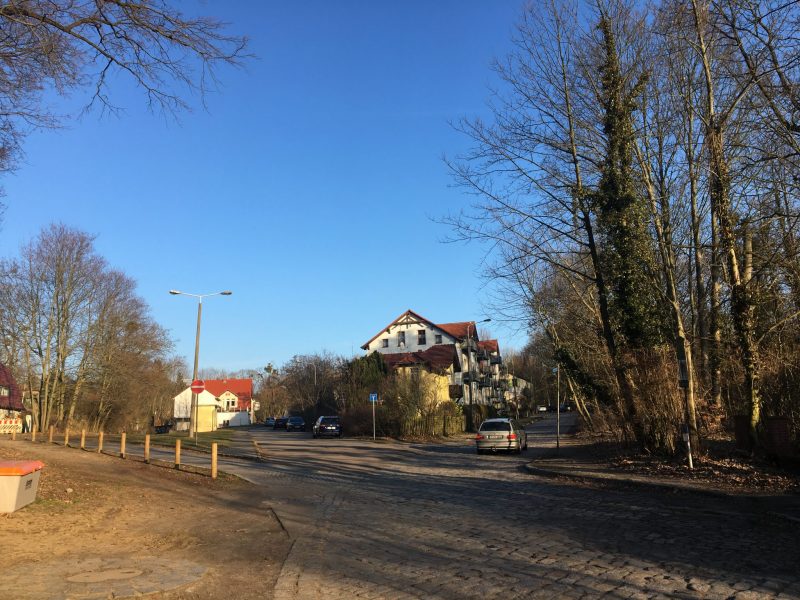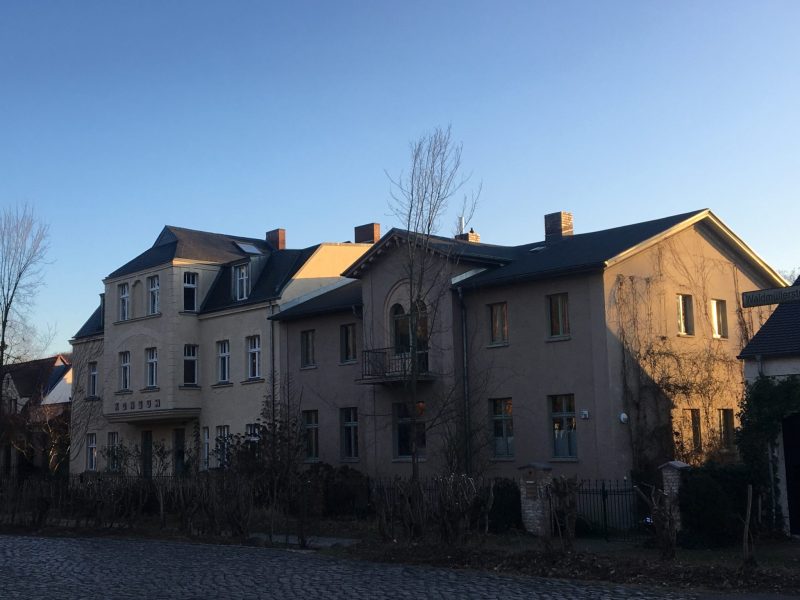Klein Glienicke: from Resort to “Restricted Area”
Only thirty years ago the tiny settlement “Klein Glienicke” between Berlin and Potsdam (where it belonged) was surrounded with the double wall with barbed wire on top. You could get inside from Babelsberg park side but only if you had a special permission. Actually, marvelous landscape surrounded the “restricted area” from all the sides (besides Babelsberg park there were also Park Glienicke, the Gribnitzsee Lake and the park around the hunting castle) but nobody of residents could take a benefit of it because of the wall.
The history of Klein Glienicke ist unique starting about 150 years ago as Prince Carl of Prussia, the third son of Frederik William III arranged a homely village near his own estate and the Hunting Castle in a Swiss style. The orphans living in the castle were resettled there as Carl bought the castle for his own son. In contrast to his brothers fond of Italian and Neo – Gothic architecture, he admired this mountain land with alpine meadows, turbulent rivers and wooden houses decorated with elaborate carving. It was a perfect place for a “Swiss village”, with some humps and сreek already there, but also with an artificial “Böthherberg” hill where “Loggia Alexandra” was errected in the memory of Princess Charlotte, the beloved Carls sister as well as the spouse of Russian Tsar Nikolai I. And at the beginning of the 20th century as Potsdam came in fashion among the “beau mond” of Berlin, the Swiss village only 28 sq. m. big (just a bit more than a square with half a kilometer side) turned into a real resort. Villas grew here and in neighboring Neubabelsberg like mushrooms, with hotels fully booked. Picnics and walks, boating, swimming, party nights… But then the Nazis came to power. Many villas owners of Jewish origin sold them cheap or just left them in a hurry to go away, preferably overseas. The movie star Lilian Harvey returned from Hollywood to Nazi Germany but quickly realized her mistake and left back, leaving here a whole castle on the shore of the Havel. And in June 1934 the last Reich Chancellor of Weimar Germany Kurt von Schleicher, was shot dead with his wife in his house at Gribnitsstrasse 4. The teenage daughter found their corpses covered with blood as she returned from school. Since then the world was no longer the same for her, as well as for a lot of other inhabitants of the former paradise. Soon after that the war began. And as it was over, the enclave formally belonging to the GDR turned out to be surrounded by capitalist enemies on all sides.
In 1961a wall similar to Berlin wall grew around a tiny village At first it was single, then became double, the old trees being cut down and villas and “Swiss houses” blown up as they stood in the way. Looking at the map you can easily see the “butterfly” on the Berlin side, south of the highway leading from the Glienicke bridge, “the Bridge of Unity”, as it was named in German Democratic Republic. The body of this butterfly was fettered a concrete frame on all sides for the long 28 years. And now try to imagine how the people felt falling into this trap: just after the war one could leave the house he was born and raised , but the wall made this impossible. Many residents of the enclave were separated for long 28 years from friends, relatives and neighbors in Berlin Wannsee around the corner. Parents could not see the wedding of their children. The pastor standing at the grave of the local cemetery tried to read as loud as possible for the relatives crowding at the other side of the wall. And the pastor was taken hostage himself, deprived of the other two entrusted parishes to be reached by boat on the Havel. As for the local chapel built by the famous Persius, it fell into disrepair due to the leaky roof one was not allowed to mend, since the workers used to jumped from there straight to the land of West Berlin.
Navigation on Havel continued of course, although you had to make an impenetrable face passing under the “Unity Bridge” from GDR to GDR and not to respond to familiar West Berliner waving from above, in order to demonstrate your trustworthiness. Otherwise you could have been resettled from the place you were born and raised. But is spite of all that somebody was evicted now and then, and a specially created “troika” selected then the proven candidates. Also those of course, who had to observe the neighbors if they listen to “enemy voices” on the radio or even watch something on TV not obstructed by the wall. Patrols on duty visited the houses checking if there were any shovels – and if so, for what purpose, or, even worse, high staircases to be placed at the wall. Officially, only one person in the village responsible for the repair of lanterns was allowed to have it – but nonetheless, people kept disappearing, only a staircase left behind them. And so the patrol came again then, and marked everyone by name in order to find out who was missing this time and to punish the remaining relatives. Sure it was one of the reasons for many to keep staying. Although it was so tempting to escape from here! Once, a colleague of the “Swiss house” owner came to a party with her five-year-old son and jumped out with him from the balcony “to the West.” As it turned out, she arranged everything in advance, and they were already awaited with stretched blankets. Although injured himself on the barbed wire when jumping and a skirmish ensued immediately, nobody suffered. With the exception of the house owner, of course, who was arrested.
A completely unique case of escape occurred in the dry summer of 1973: nine people, four adults and five children, escaped all together through a 19-meter tunnel dug… with a shovel without a handle and a children’s scoop. The tunnel was professionally fixed with wood and even had electrical wiring. Two fugitive families were relatives, one of them living in Klein Glienicke, and the other, with three children, in Erfurt. With the permission to visit relatives the guests from Erfurt came and at once set to work, together with the owners : the men dug, and the women eliminated the “traces of crime”, scattering dug sand in the corners of the basement and other secluded places.
But as the two weeks were over, the tunnel was not yet ready, and the family from Erfurt had to go home. And so they did, taking one of the children with them, supposedly on vacation. For the other two they managed to prolong the permission for the stay with their uncle and aunt. The same evening the “vacationer” came back in Klein Glienicke, this time illegally, of course, in the trunk of his brothers car. There was no minute to lose as it could start to rain any day. And on the same day as the work was finally completed the other “vacationers” returned in the same trunk to Klein Glienicke as well. As the night fell everybody descended into the tunnel. In spite of some problems (the woman from Erfurt fainted after such a day) soon they were already on free land, where a patrol was waiting for them to transfer them to the refugee camp in Marienfelde. And the patrol discovered the tunnel only the next morning, wondering themselves how did not they grow suspicious of fresh cut boards in the garden and completely forgot about abnormally low level of groundwater due to the drought.
There is a lot more to tell about Klein Glienicke. For instance, about one of the residents who tore down by himself the wall near his house. Berlin Wall was already torn down for some time, but here Klein Glienicke the time seemed to stop. And as soon as the piece of the wall hiding the marvelous Griebnitzsee disappeared, the “comrades” appeared immediately, although not sure to react properly. There is to tell about a family that bought “the dream house” in the late thirties here, suffering all the years of socialist enclave because of it, and lost the process to its former owners as the freedom came. Or about a lady also fond of her house she grew up in, who spent all these years behind the wall and now cannot make herself close the doors as a result of mental disturbance. There is also to tell about the exclusive realtors and owners of rich cars coming around the day the wall fell and about the families who had to leave because of the high rent as Klein Glienicke came in fashion again.
Walk along the streets of Klein Glienicke. Little is left of the former life here, except for the letters “KONSUM” on the GDR store and some devastated houses, which will also be bought and reconstructed in the nearest future. The chapel, closed in the mid-seventies, was restored for donations, and today you can admire its beauty and listen there to organ concerts. Most of the mansions of the last century have been restored. New housing, luxury and ordinary, has been built next to them, and between the trees you can also see some Swiss houses which remember everything.










